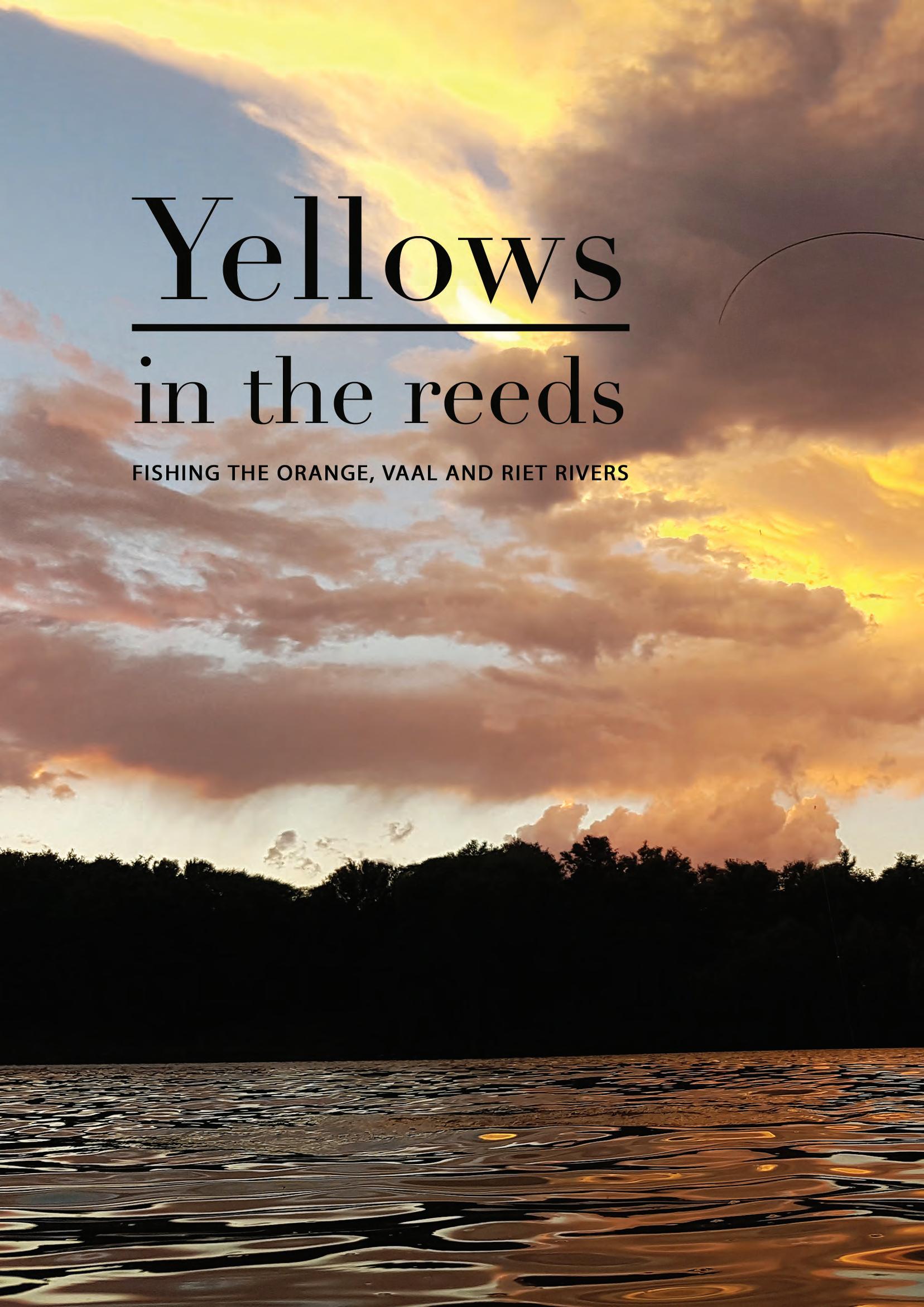
15 minute read
Fishing the orange Vaal and Reit Rivers
By Andrew Mather
The dawn held its chilly hand over the camp as the sun pushed up over the horizon. Cold air seeped into my bed while I fought to keep my eyes closed to nap for a few more minutes; it was then I remembered I was on a fishing trip! I sprang out of bed, the cold forgotten, excited at the day that lay ahead at Hunter Fisher’s Orange River fishing camp.
Advertisement
It is not often that a fishing trip exceeds one’s expectations, but this trip proved to be one of those occasions.
The gathering place after fishing.

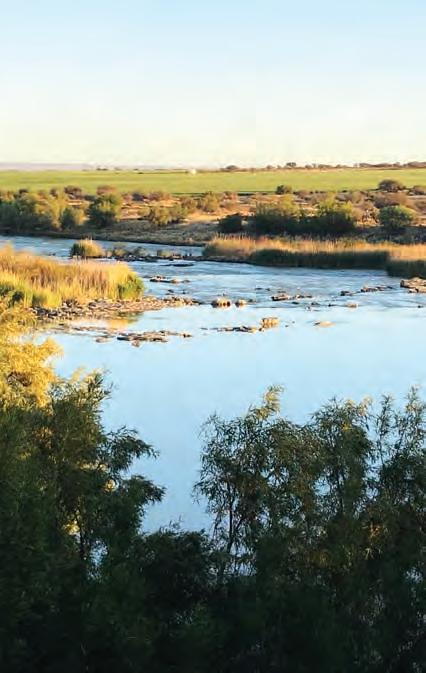
Owned and operated by former national flyfishing champion and present day professional hunter and flyfishing guide Jacques Marais, the camp is on a secluded stretch of the river a few kilometres from Douglas. The camp which is one of many operated throughout Southern Africa by Hunter Fisher can accommodate up to 12 fishermen in private luxury tents set up along the riverbank. Ablution facilities are located conveniently at each end of the camp and, although basic, are clean and fit for purpose. Most importantly, they provide a never ending supply of steaming hot water for that early morning wake-up shower and the revitalising shower that is so necessary after a day’s fishing.
There is no need to draw straws to see who sleeps with the snorer when fishing with Jacques! The sense of solitude is profound, especially in the morning.
The main building is a lounge/diningroom and kitchen facility with a viewing deck and pub overlooking the river.
The food needs a special mention. They say an army runs on it stomach, but this is true of flyfishers too. The food is absolutely world class. The fishing was superb, but it is one of those quirks of human nature that one often remembers the food best. Well Jacques made this easy; his team served up fantastic evening meals using the game that Jacques had shot. After the main course, desert followed, although by this time the lads usually drift to the bar. The bar isn’t a typical bar, though — Jacques has his fly-tying vice set up permanently in the middle of it. Sitting around the bar sipping after dinner drinks of your choice, is made complete by Jacques recounting fishing stories while tying flies long into the night.
Jacques keeps a small stock of essential flyfishing equipment on hand in case you are not set up for the conditions, but it’s his flies that are the winners. Regular visitors get their orders in for the latest “special flies” that are currently producing fish and a few “secret flies” too. Don’t worry if you haven’t fished for yellows before because Jacques will set up your rig and get you sorted with flies and into fish in no time. But I’m getting ahead of myself again ...
The camp is conveniently located to enable you to fish both the Vaal and Riet rivers which is great because if the Orange is running too full and dirty there is always the Riet.
BUCKLANDS, VAAL RIVER Rising around 5am the first day full of excitement, we watched the sun rise over the Orange River. It was spectacular; what a special place it is. Rob Hibbert had some decent filter coffee on the go, and while we drank our coffee and ate rusks we watched Jacques tying flies.
After breakfast we headed out to the Vaal River, just up from the confluence with the Orange River, on a farm called Bucklands. The plan was to spend the whole day at the river. This beat was several kilometres long, and by the time I got to the river’s edge after negotiat
The Orange River at sunrise. Typical Orange RIver waters.
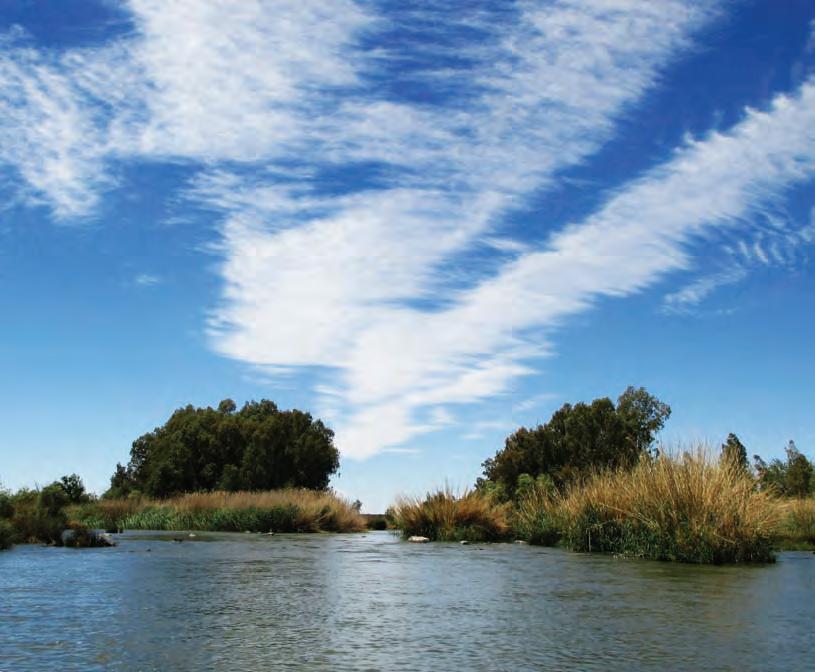
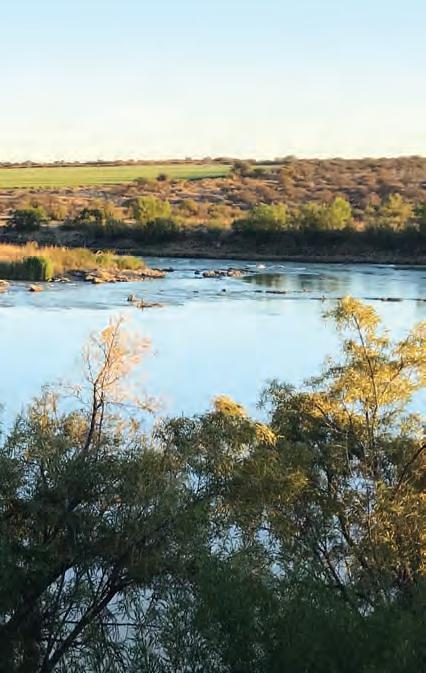
ing a barbed wire fence that could have easily torn pieces out of my nether regions, Keegan Kennedy was already into a fish in the large pool just downstream of the riffle. The water was flowing nicely, but was so dirty that couldn’t see the river bottom in knee-high water.
All the lads were soon into fish, and mudfish dominated the catches. There must have been thousands in the water unseen by us, as many were hooked in the dorsal fin. When this happened the muddie took off and you had a hell of a job managing the run. Fortunately, or unfortunately, depending on what species you were keen to catch, the hook often popped out. A “long-range release” as we euphemistically called it.
After a while some of the guys headed upstream but I decided to stay put between the lower pool, upstream pool and the riffle between them. I fished up the riffle, crossed over and came in from the opposite bank into the upper pool. It was probably 80m across and knee deep. I started nymphing, working my way across the pool. Did I mention I hate nymphing?. With barely 2m of line out my 10ft Orvis 4-wt, fishing consisted of a flick, track, flick, track, flick, track!. I bet Jacques would disagree!
I’d caught a few fish but the monotony was getting to me in the heat of the day. I had rigged up a control fly with a dropper, a size 18 brown soft hackle fly that Wayne Stegen tied at Durban Fly Tyers. Most of the fish were taking the control fly, an orange tungsten bead-headed caddis.
With the shallow water I’d had a few hook ups with rocks and it just so happened that I hooked a rock again. Not wanting to break off the fly, my standard practice was to wade over and reach down and release the fly or use my wading staff to push the line down to release the fly from the rock. I kept the pressure on so I could work my way to the fly. As I got to within two feet of the fly the line moved sideways. Suddenly I realised I’d hooked something solid, but the fish didn’t seem to be putting up a fight; it just seemed to move slowly and I couldn’t get it to make a run. The muddies we’d been catching behaved like this but then they would suddenly make a decent run. I waited. No run. The fish just kept moving slowly around and not showing itself.
Now a couple of fish had already run me to my backing by heading downstream, so I was trying not to let this happen again. If the fish moved right I followed, when she went left I followed like a strange dance except I couldn’t see my dance partner. Slowly the fish realised that it was getting some outside force pulling it although the pressure was fairly light as I was using 4 lb tippet. Now that was a decision I was regretting. For 25 minutes the fish lead me on a tour of the pool. At one stage she got behind me and I had visions of her running downstream, so I put as much pressure on her as I thought I could without popping the tippet.
At this stage I got my first glimpse of her — a huge grass carp which I estimate was about four foot in length, with a size 18 soft hackle in her mouth! This was about the time I started to worry about trying to land her. My Xplorer net suddenly didn’t look as big as I’d thought and here was no way I could net her. Plan B quickly kicked in. I would tried leading her into the shallows and then make a grab. After all, she didn’t look particularly fast moving. If I were a betting man I would reckon my chances were almost impossible, but I had to give it a go.
The fish came in shallower and shallower and was now less than a rod length away, lying slightly on her side in the shallows; just a bit more and she would be mine. I put more pressure on the rod, and as she started to move into an ideal place for me to pounce, pop went the 4 lb tippet! I stood frozen like I was superglued into position. She gradually turned and majestically swam off towards the centre of the pool. I watched. I wept. I was shaking.
I waded out the pool and sat down on the bank, reliving every moment. What if I had played her a little longer? Damn that 4 lb tippet! What did she weigh? What a beautiful specimen; the side view of her is indelibly etched in my mind. Perhaps it did turn out okay — I finally got to see my dance partner, she was beautiful and she blew me a kiss before saying goodbye.
I think I sat on the bank for nearly an hour eating my lunch and redoing my tippet — 6 lb fluorocarbon this time. I fished the lower pool for the rest of the afternoon, catching a number of nice sized muddies and smallmouth yellows; I stopped counting once I got into double figures. It was a good day and the final tally for the group was about 140 fish.
THE RIET RIVER The Riet River is special in that, unlike the Orange, it usually runs clean. The river flows through a well-eroded streambed with quite a lot of rocky areas that create riffle sections and large pools. It also has quite a lot of weed strung out in lines like an English chalkstream, with open sections in between. It’s here that you find an abundance of large- and smallmouth yellowfish.
On this day we split into small groups and headed for the Riet. I found myself walking across a slippery, rocky floodplain that reminded me of a moonscape; I was grateful for my felt-soled boots as it would have been hard going wading without them.
The river — once I reached it — reminded me of a larger version of the clear streams of the
20 • Return to contents Client w
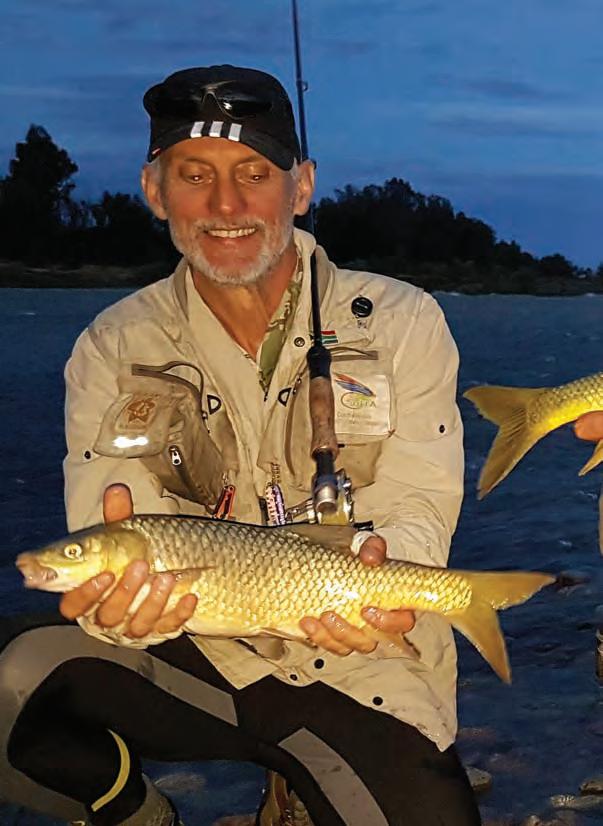
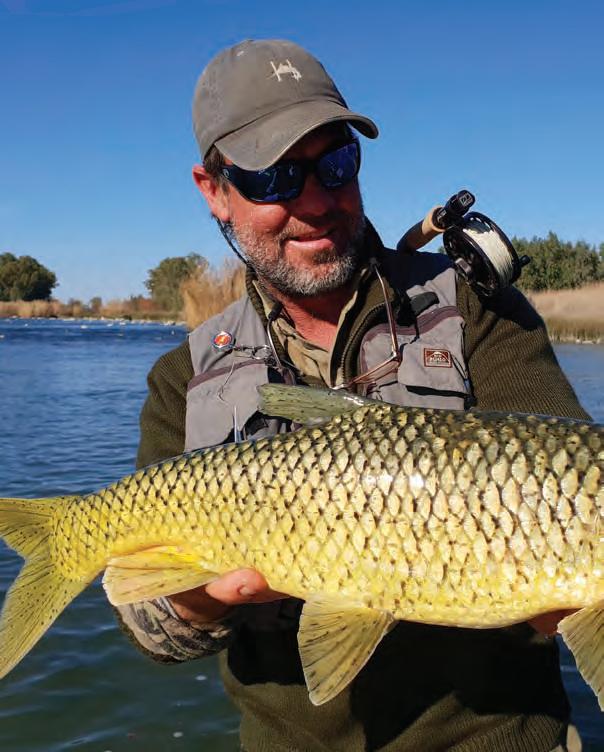
with a trophy smallmouth. Jacques Marais with a trophy smallmouth yellow.
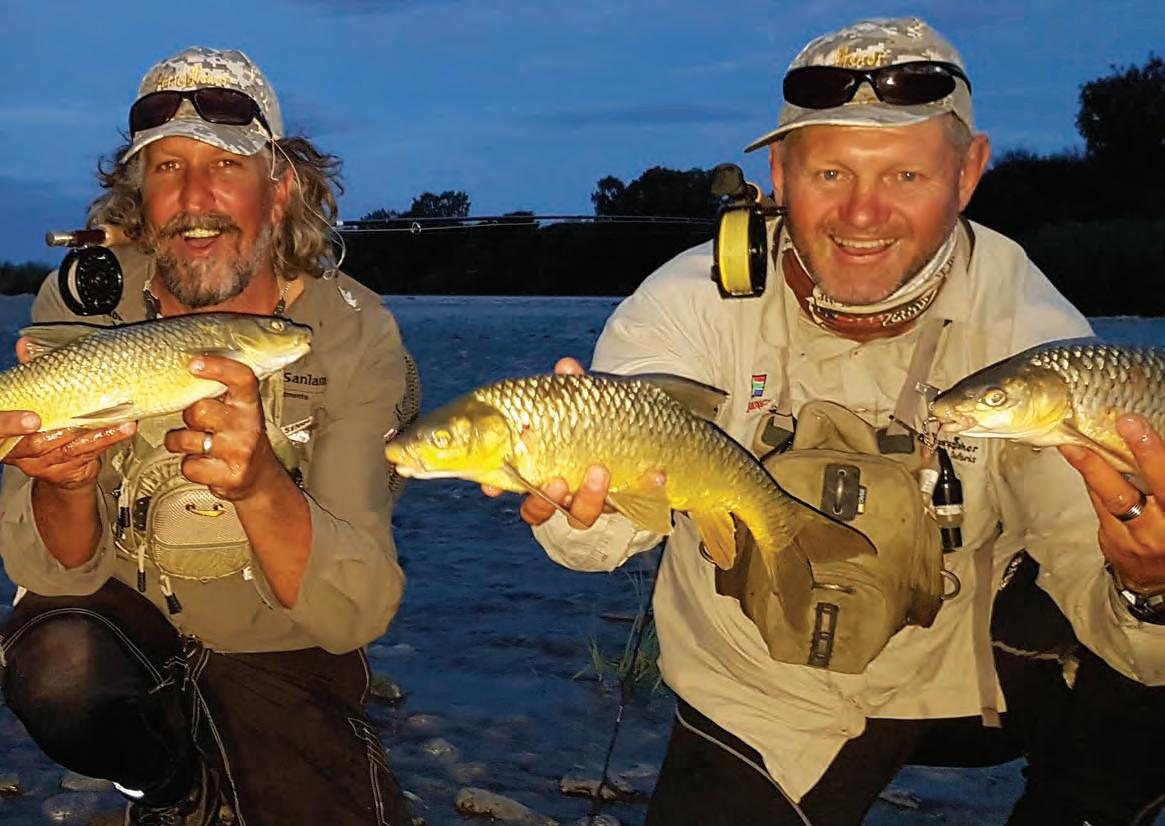
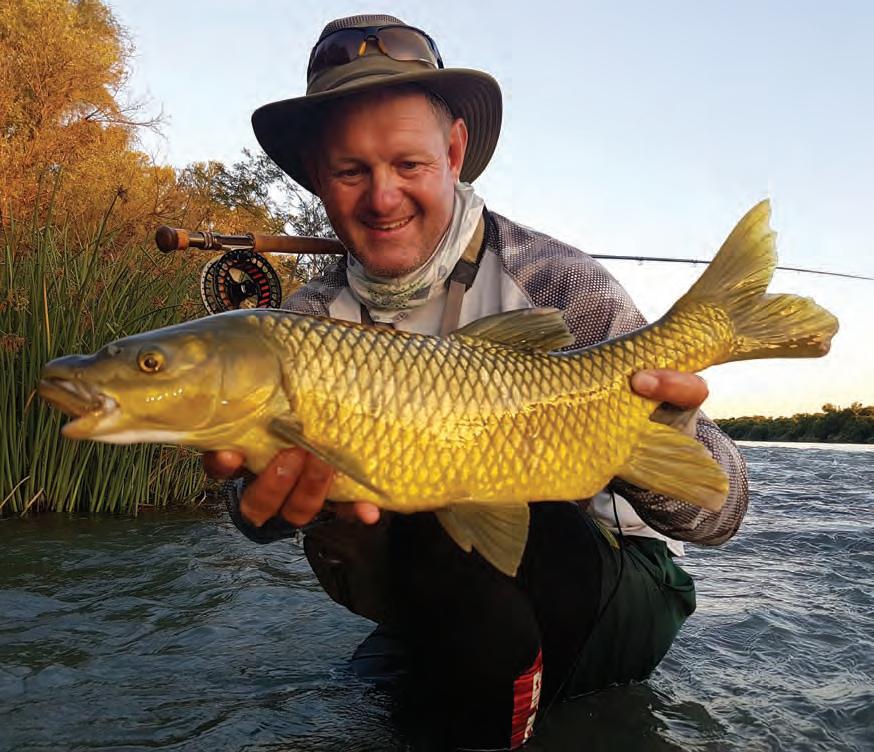

Drakensberg, so I slipped into small stream mode and tied on a dry and dropper tied on New Zealand-style. I focused on casting into the flowing clear water channels. After several casts my elk hair caddis literally jumped 10cm sideways. Surprised and probably overcome with the ferocious take, I raised my rod a little too quickly and the 4 lb tippet parted. Several large fish were seen cruising the channels but no nymphs dangled in front of them could induce a take. My guess was that they had seen me after that and they all got lockjaw. It’s a dilemma — low, clear conditions and big, strong fish. Big flies were out, as was thick tippet. Some of the lads fished 6x with some success, but fishing was technically diffi

Carp abound.
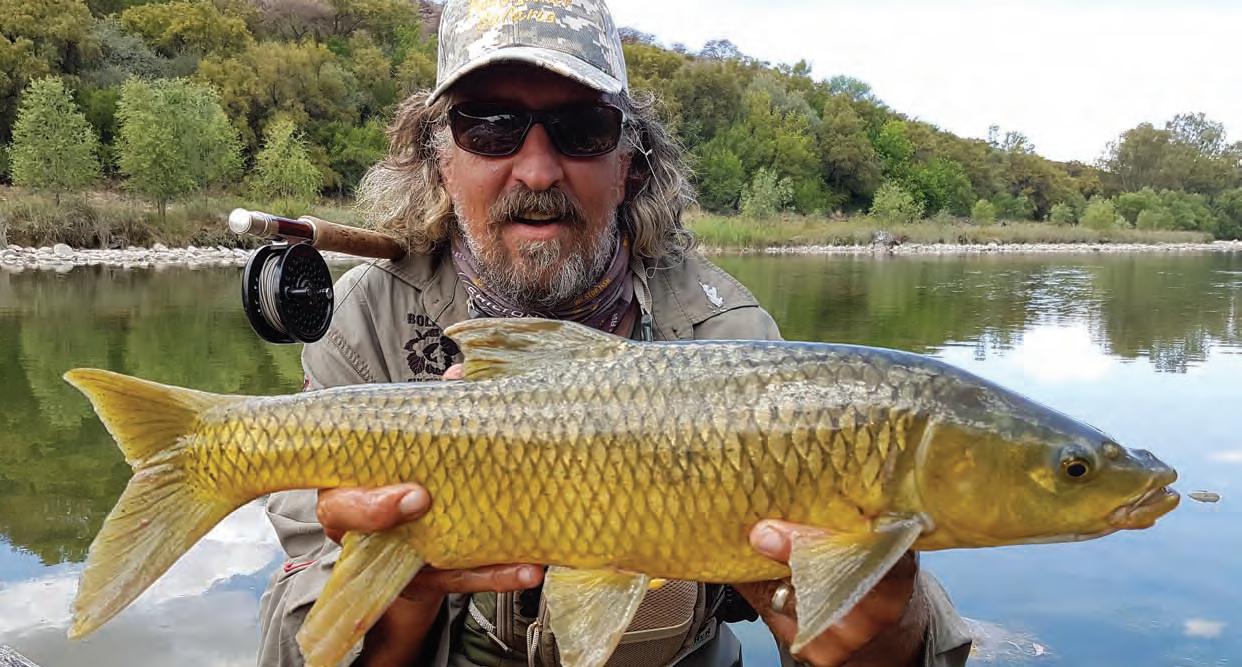
cult although exciting.
Nonetheless I decided to persevere with my dry (a cream CDC and Elk) and dropper rig the next day. I waded out to a small island that lay alongside the main channel and which was situated just above the start of a large, relatively weed-free pool. I could see fish moving up the channels and circulating back into the pool but I couldn’t see the full extent of the pool as the reeds hid much of it.
I concluded that casting directly at a fish in these clear conditions would spook them, so instead I cast 5- or 6m upstream of the pool in and let the flies drift down into the head of the pool. It was a good decision and it didn’t take me long to hook up.
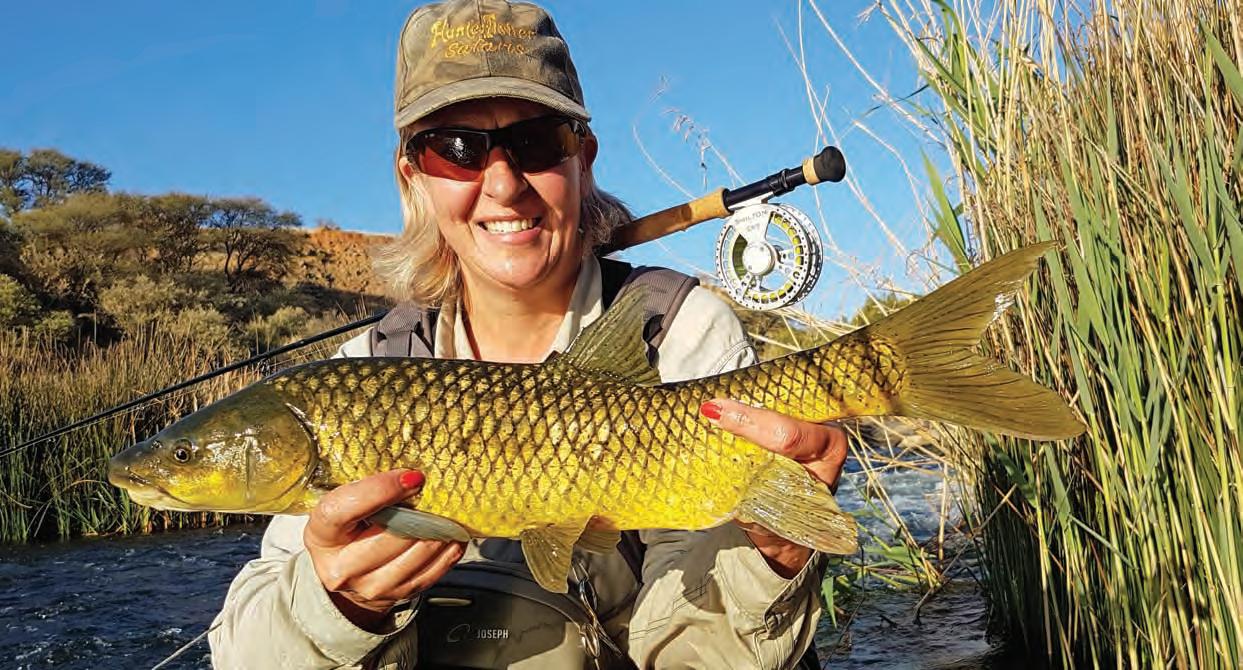
A Riet River yellow.
26 • Return to contents The fly had just drifted into the pool when bang, the dry disappeared and my line went berserk.
I nursed this one a bit, the memories of the previous day’s breakups still fresh in my mind. I really wanted to be able to say I got a Riet River yellow, but the fish had other ideas. He ran upstream, trying to lodge himself in the weeds; evasive action was required. This bent my 10ft 4-wt Orvis to almost breaking point but I managed to turn the fish downstream.
The fish then tried to run downstream through the pool so I cranked up the drag. This game of man vs fish went on for several minutes. Just when I thought I was winning, the fish headed into the weeds that I had been hiding behind. I was determined that this one was not getting away, and I waded into the river to free my tippet which had become tangled in the reeds. Unfortunately I slipped on a loose rock and properly fell into the river.
Icy cold water heightens the the senses and quickens one’s reactions, and I was no different. Aided by the sudden stimulus of a cold dunking, I quickly recovered and netted the fish. It measured 18 inches and had given me a good run for my money; no wonder they are popular targets for anglers.
I wasn’t the only one getting wet. Rob Hibbert, crossing the Riet about 80m upstream of me, slipped and all but disappeared into a deep pool. All I could see was his Simms cap. Spluttering and drenched, he waded to the bank only to fall in again. He eventually beached himself but had to sit it out in the sun for a while in order to warm up and dry out.
Rob was not the only one in need of the sun’s warming caress. I too sat it out for a while, ostensibly to let the pool rest. I reasoned my impromptu swim had caused the fish to gap it for quieter waters.
After about 15 minutes I could see that yellows were once against cruising the channels. I repeated my tactic of casting upstream and letting the current drift my flies down into the pool. This time the take was in the channel; the fish had clearly been holding in the weeds out of sight. This one took off through the weed bank and snapped me off.
I rested the pool again. Next cast the fly once again entered the pool and got taken. After a great tussle the fish came to the net. I continued hooking fish and then resting the pool, only casting when the fish were cruising again.
One of my drifts did not induce a take, so I let line out as the fly headed down over the pool. I had difficulty seeing the fly as the weeds I’d
used to hide behind were so thick I had to lean out to see it. At about this time I realised my fly line had looped around the reel, so I stopped to sort it out before once again stripping back line so I could recast. Suddenly something hit my fly — hard! The fish, having taken my fly, turned around and rocketed downstream. The reel started screaming and then the tippet popped. I wonder if it was a largie; I guess I’ll never know. I went on to hook 11 fish but only seven made it to the net. What a day! A very good reason to want to come back again.
Summing up, the Riet River is a fantastic destination for yellows. The water clarity for one requires a different approach to fishing, and it is a technically challenging river to fish. Yellows are surprisingly clever, mostly out smarting any anglers that aren’t concealing themselves and using stealth to target these fish. Our experience as a group is that one won’t catch large numbers of fish, but each one caught will be very rewarding.
DIE GEUT Our last day was spent at Die Geut — The Gutter — a stretch of the Orange that has a large rock sill across the whole river. The rock sill is probably about 4 foot high and dams the river up at this point. The river is probably about 200m wide here, and while the flow rate was down it’s still a great spot to fish. Most of the lads chose to fish the riffles downstream of the sill.
Jacques obviously saved the best stretch for the last day, because as we were kitting up the fish in the shallows were thrashing about in a carnal frenzy. There were literally hundreds of them in the shallows. But no sooner had we stepped into the water than they dashed off like dark torpedoes into deeper water.
The lads strung themselves out along the riffle like a chain and started nymphing. Before long rods were bending everywhere, and sometimes several fish were being fought together.
Midway through the morning one of the guys shouted at me and I turned to see my floating orange Xplorer net rapidly moving downstream. Luckily for me Rob valiantly cast and hooked my net; I owe him as the casting screwed up his leader and he had to sit out and redo it. I was most grateful, though, as it would have been almost impossible to land fish there without a net.
Not long after my net went walkabout I saw another net floating down and somebody having to do a similar rescue. It’s something to be aware of and sort out properly, because being stuck without a net could really spoil a trip like this. Barbel are commonly caught here as well.
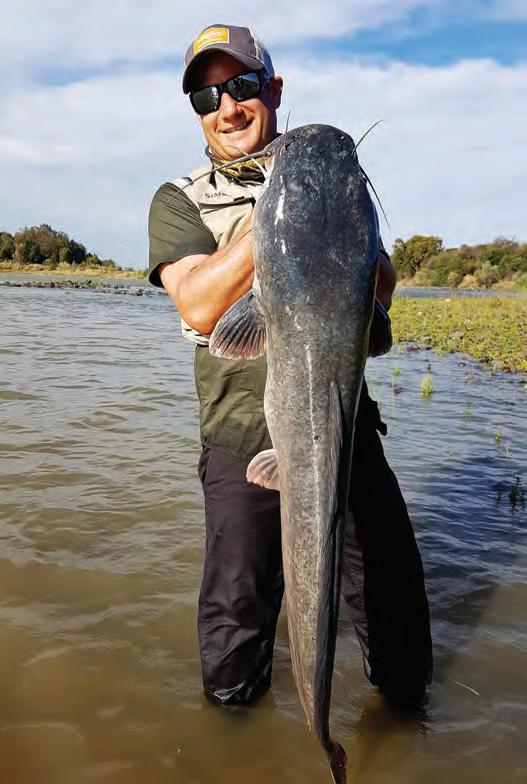
The HunterFisher strikes again.
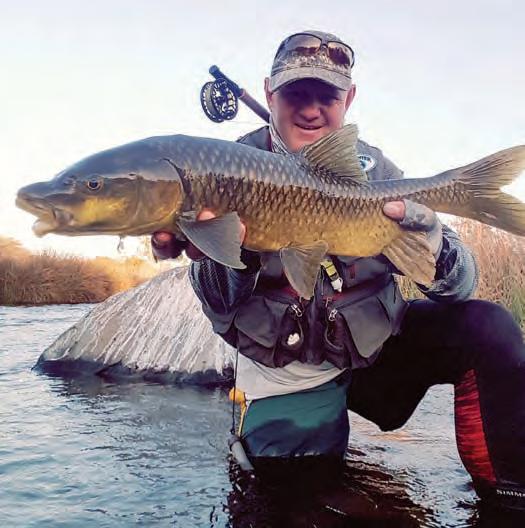
SUMMING UP In summary I can safely say that this is a world class fishery. The final tally for our group was over 500 fish in the net over three days. Countless more either broke us off or were “long line releases”. If you haven’t fished these waters yet, take it from me, you will be hard pressed to beat them, even internationally.




